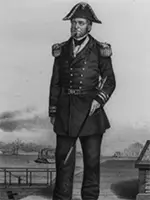The Battle of Fort Henry
The Battle of Fort Henry was a victory for the Union during the American Civil War. Seizure of the fort allowed Union troops to take control of the Tennessee River and paved the way for an invasion of Tennessee. 

Fort Henry was on the Tennessee River. Close by, on the Cumberland River, was Fort Donelson. Occupying both forts were Confederate troops. The forts and the men and guns defending them were situated so as to give the defenders control of waterborne access to the interior of Tennessee. Fort Henry, in particular, guarded the railroad route between Memphis and Bowling Green, Ky. Brig. Union Gen. Don Carlos Buell was already advancing through Kentucky, aiming to capture Nashville. If Union troops could capture Fort Henry and Fort Donelson, then they could not only aid in the overall capture of Tennessee but also deny the presence of any reinforcements from other parts of the Confederacy (and vice versa). Brig. Gen. Lloyd Tilghman commanded the forces at both forts. In January 1862, he had ordered the construction of a third fort, Fort Heiman, on the east bank of the Tennessee River, opposite Fort Henry. Those building the new fort were slaves. As it happened, Fort Henry, even though it had 17 heavy guns, had no ammunition for most of those guns; as well, the fewer than 3,000 troops who were on hand to defend Fort Henry were raw recruits, all of them, poorly trained, many of them ill, and some of them armed with flintlock rifles dating to the War of 1812. 
Union forces, meanwhile, were 15,000 strong, and supporting the invasion were three gunboats and four ironclad ships: Cincinnati (the flagship), Carondelet, Essex, and St. Louis. Commanding the invasion force for the Union was Brig. Gen. Ulysses S. Grant, who would lead the land element of the strike. Commanding the naval force was Flag Officer Andrew Foote (right). The Union troops left Cairo, Ill., on February 2 and landed just out of range of the Fort Henry guns on February 4 and 5. By that time, the Tennessee River was flooding. Fort Henry was built on low ground, and parts of it were already underwater; in addition, the magazines were damp. Tilghman, who was at Fort Donelson, traveled the short distance to Fort Henry while also dispatching a request up the chain of command for reinforcements. On the afternoon of February 5, Union gunboats and Fort Henry's guns exchanged fire and the the Union boats withdrew. Later that night, a Union strike force seized Fort Heiman without a shot because the troops found it abandoned. (Tilghman had discovered the size of the invasion force and had ordered a withdrawal.) Grant had ordered a land and water attack to begin at 11 a.m. on February 6. Just an hour before that, Tilghman ordered the troops defending Fort Henry, with the exception of those firing the big guns, to retreat to Fort Donelson. 
Grant and the army were mired in travel on the muddy roads to Fort Henry when the navy, under Foote, arrived at the fort. As the day before, both sides fired. The Union ships sustained several hits, but none sunk. Several dozen men aboard the ships died. The Union fire took out a handful of the big guns defending the fort and killed 21 Confederate defenders. At 2 p.m., Tilghman surrendered the fort and the 94 remaining defenders. Grant and his troops had yet to arrive. |
|
Social Studies for Kids
copyright 2002–2024
David White




